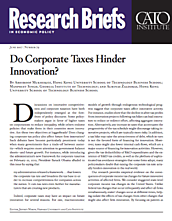Do Corporate Taxes Hinder Innovation?
Discussions on innovative competitiveness and corporate taxation have both independently emerged at the forefront of policy discourse. Some policymakers argue in favor of higher taxes on corporations to reduce inequality, while others endorse policies that make firms in their countries more innovative. Are these two objectives at loggerheads? Does changing corporate tax policy also affect future firm innovation? Such debates have become particularly prominent today when many governments face a trade-off between austerity — which requires more attention to government balance sheets — and future growth. For instance, while introducing the administration’s new framework for corporate taxation on February 22, 2012, President Barack Obama alluded to this issue by saying that
my administration released a framework … that lowers the corporate tax rate and broadens the tax base in order to increase competitiveness for companies across the nation. It cuts tax rates even further for manufacturers that are creating new products.
Indeed, corporate taxes may have an impact on future innovation for several reasons. For one, macroeconomic models of growth through endogenous technological progress suggest that corporate taxes affect innovative activity. For instance, studies show that the decline in after-tax profits from innovation projects following tax hikes can lead innovators to reduce or redirect effort, affecting aggregate innovation. Alternatively, any increase in taxes that accentuates the progressivity of the tax schedule might discourage taking innovative projects, which are typically more risky. In addition, a tax hike may raise the attractiveness of debt, which in turn is not the favored form of financing for innovation. Moreover, taxes might also lower internal cash flows, which are a major source of financing for innovation activities. However, given the tax deductibility of R&D expenditures and the existence of R&D tax credits, as well as the plethora of sophisticated tax avoidance strategies that some firms adopt, many policymakers doubt that raising the corporate tax rate actually hinders innovation in the real world.
Our research provides empirical evidence on the consequences of corporate income tax changes for future innovative activities of affected firms. We consider staggered state-level corporate income tax changes in the United States. Unlike federal tax changes that occur infrequently and affect all firms simultaneously, states’ changes occur at different times, helping isolate the effects of tax changes from other changes that might also affect firm innovation. By focusing on patents as our measure of innovation, we find that firms become less innovative following an increase in the rate at which their home state taxes corporate income. In terms of economic magnitude, a 1.5 percentage point increase in the state corporate income tax rate from a mean value of around 7 percent leads to approximately 37 percent of affected firms to file one fewer patent within the next two years, compared to a mean of about 9.1 patents per firm-year. When we consider tax increases and decreases separately, we find that most of this effect comes from increases.
Importantly, we also find that the decline in innovation is not limited to patenting activity — the drop in patenting is accompanied by a decline in R&D investment as well as a decline in new product introductions, which we measure using a novel textual analysis-based metric. These findings, taken together, imply that the effect of corporate taxes seems to pervade all stages of innovation.
Causal interpretation of our estimates requires that, conditional on the controls we use, our treated and nontreated firms are not systematically different. For example, one issue for our analysis might be that states change tax rates on the basis of local economic conditions, which might directly affect a firm’s incentives to innovate, aside from its indirect effect through taxes. We perform a series of tests to address such concerns carefully. First, our results are robust to many perturbations, including controlling for coincidental tax changes. Second, we perform a stringent test to rule out local economic condition effects contaminating our evidence, based on policy discontinuity at state borders. In particular, we confine our analysis to firms located in contiguous counties on two sides of a state border. In this test, we directly net out the effects of local economic conditions.
Our results show that the average firm that faces a tax rise files approximately one fewer patent two years following the increase, as compared to its neighbor on the other side of the state border that is not affected by any tax change. These results are robust if we look only at bordering states with the same political party in power or if we focus on the more exogenous and unexpected tax changes, which we identify through historic newspaper records.
Our results contribute to the literature that discusses the determinants of innovation. Empirical evidence shows that product market competition, institutional ownership, presence of financial analysts, investors’ attitudes toward failure, financial development, labor laws, managerial contracts, stock liquidity, investment cycles in financial markets, banking deregulation, and private rather than public ownership all affect innovation. We contribute to this literature by showing that corporate taxes are a first-order determinant.
NOTE:
This research brief is based on Abhiroop Mukherjee, Manpreet Singh, and Alminas Žaldokas, “Do Corporate Taxes Hinder Innovation?” Journal of Financial Economics, April 2017, https://doi.org/10.1016/j.jfineco.2017.01.004.
About the Authors

This work is licensed under a Creative Commons Attribution-NonCommercial-ShareAlike 4.0 International License.
